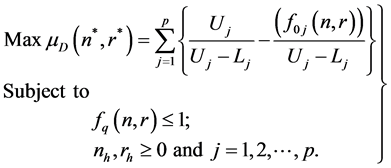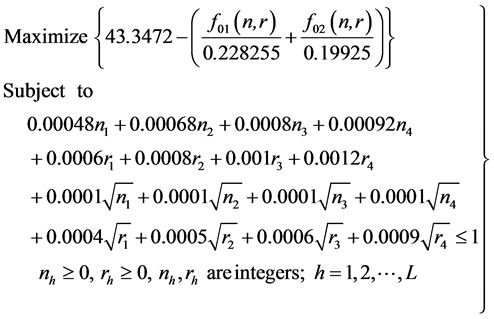American Journal of Operations Research
Vol.4 No.3(2014), Article ID:46125,16 pages
DOI:10.4236/ajor.2014.43017
Fuzzy Geometric Programming in Multivariate Stratified Sample Surveys in Presence of Non-Response with Quadratic Cost Function
Shafiullah1, Mohammad Faisal Khan2, Irfan Ali1
1Department of Statistics & Operations Research, Aligarh Muslim University, Aligarh, India
2Department of Computing and Informatics Saudi Electronics University, Riyadh, Saudi Arabia
Email: shafi.stats@gmail.com, faisalkhan004@yahoo.com, irfii.ali@gmail.com
Copyright © 2014 by authors and Scientific Research Publishing Inc.
This work is licensed under the Creative Commons Attribution International License (CC BY).
http://creativecommons.org/licenses/by/4.0/



Received 19 March 2014; revised 19 April 2014; accepted 26 April 2014
ABSTRACT
In this paper, the problem of non-response with significant travel costs in multivariate stratified sample surveys has been formulated of as a Multi-Objective Geometric Programming Problem (MOGPP). The fuzzy programming approach has been described for solving the formulated MOGPP. The formulated MOGPP has been solved with the help of LINGO Software and the dual solution is obtained. The optimum allocations of sample sizes of respondents and non respondents are obtained with the help of dual solutions and primal-dual relationship theorem. A numerical example is given to illustrate the procedure.
Keywords:Geometric Programming, Fuzzy Programming, Non-Response with Travel Cost, Optimum Allocations, Multivariate Stratified Sample Surveys

1. Introduction
In sampling the precision of an estimator of the population parameters depends on the size of the sample and variability among the units of the population. If the population is heterogeneous and size of the sample depends on the cost of the survey, then it is likely to be impossible to get a sufficiently precise estimate with the help of simple random sampling from the entire population. In order to estimate the population mean or total with greater precision, the heterogeneous population is divided into mutually-exclusive, exhaustive and non-overlapping strata which will be more homogeneous than the entire population. The entire population is called Stratified Random Sampling. The problem of optimum allocation in stratified random sampling for univariate population is well known in sampling literature; see for example Cochran [1] and Sukhatme et al. [2] . In multivariate stratified sample surveys problems the non-response can appear when the required data are not obtained. The problem of non-response may occur due to the refusal by respondents or their not being at home, making the information of sample inaccessible. The problem of non-response occurs in almost all surveys. The extent of nonresponse depends on various factors such as type of the target population, type of the survey and the time of survey. For the problem of non-response in stratified sampling it may be assumed that every stratum is divided into two mutually exclusive and exhaustive groups of respondents and non respondents.
Hansen and Hurwitz [3] presented a classical non-response theory which was first developed for surveys in which the first attempt was made by mailing the questionnaires and a second attempt was made by personal interviews to a sub sample of the non respondents. They constructed the estimator for the population mean and derived the expression for its variance and also worked out the optimum sampling fraction among the non respondents. El-Badry [4] further extended the Hansen and Hurwitz’s technique by sending waves of questionnaires to the non respondent units to increase the response rate. The generalized El-Badry’s approach for different sampling design was given by Foradori [5] . Srinath [6] suggested the selection of sub samples by making several attempts. Khare [7] investigated the problem of optimum allocation in stratified sampling in presence of nonresponse for fixed cost as well as for fixed precision of the estimate. Khan et al. [8] suggested a technique for the problem of determining the optimum allocation and the optimum sizes of subsamples to various strata in multivariate stratified sampling in presence of non-response which is formulated as a Nonlinear Programming Problem (NLPP). Varshney et al. [9] formulated the multivariate stratified random sampling in the presence of non-response as a Multi-objective Integer Nonlinear Programming problem and a solution procedure is developed using lexicographic goal programming technique to determine the compromise allocation. Fatima and Ahsan [10] addressed the problem of optimum allocation in stratified sampling in the presence of non-response and formulated as an All Integer Nonlinear Programming Problem (AINLPP). Varshney et al. [11] have considered the multivariate stratified population with unknown strata weights and an optimum sampling design is proposed in the presence of non-response to estimate the unknown population means using DSS strategy and developed a solution procedure using Goal Programming technique and obtained an integer solution directly by the optimization software LINGO. Raghav et al. [12] has discussed the various multi-objective optimization techniques in the multivariate stratified sample surveys in case of non-response.
Geometric Programming (GP) is a smooth, systematic and an effective non-linear programming method used for solving the problems of sample surveys, management, transportation, engineering design etc. that takes the form of convex programming. The convex programming problems occurring in GP are generally represented by an exponential or power function. GP has certain advantages over the other optimization methods because it is usually much simpler to work with the dual than the primal one. The degree of difficulty (DD) plays a significant role for solving a non-linear programming problem by GP method.
Geometric Programming (GP) has been known as an optimization tool for solving the problems in various fields from 1960’s. Duffin, Peterson and Zener [13] and also Zener [14] have discussed the basic concepts and theories of GP with application in engineering in their books. Beightler, C.S., and Phililps, D.T. [15] , have also published a famous book on GP and its application. Davis and Rudolph [16] applied GP to optimal allocation of integrated samples in quality control. Ahmed and Charles [17] applied geometric programming to obtain the optimum allocation problems in multivariate double sampling. Ojha, A.K. and Das, A.K. [18] have taken the MultiObjective Geometric Programming Problem being cost coefficient as continuous function with weighted mean and used the geometric programming technique for the solutions. Maqbool et al. [19] and Shafiullah et al. [20] have discussed the geometric programming approach to find the optimum allocations in multivariate two-stage sampling and three-stage sample surveys respectively.
In many real-world decision-making problems of sample surveys, environmental, social, economical and technical areas are of multiple-objectives. It is significant to realize that multiple objectives are often non-commensurable and in conflict with each other in optimization problems. The multi-objective models with fuzzy objectives are more realistic than deterministic of it. The concept of fuzzy set theory was firstly given by Zadeh [21] . Later on, Bellman and Zadeh [22] used the fuzzy set theory for the decision-making problem. Tanaka et al. [23] introduces the objective as fuzzy goal over the α-cut of a fuzzy constraint set and Zimmermann [24] gave the concept to solve multi-objective linear-programming problem. Biswal [25] and Verma [26] developed fuzzy geometric programming technique to solve Multi-Objective Geometric Programming (MOGP) problem. Islam [27] [28] has discussed modified geometric programming problem and its applications and also another fuzzy geometric programming technique to solve MOGPP and its applications. Fuzzy mathematical programming has been applied to several fields.
In this paper, we have formulated the problem of non-response with significant travel
cost where the cost is quadratic in
 in multivariate stratified sample surveys as a Multi-Objective Geometric Programming
problem (MOGPP). The fuzzy programming approach has been described for solving the
formulated MOGPP and the optimum allocations of sample sizes of respondents and
non respondents are obtained. A numerical example is given to illustrate the procedure.
in multivariate stratified sample surveys as a Multi-Objective Geometric Programming
problem (MOGPP). The fuzzy programming approach has been described for solving the
formulated MOGPP and the optimum allocations of sample sizes of respondents and
non respondents are obtained. A numerical example is given to illustrate the procedure.
2. Formulation of the Problem
In stratified sampling the population of N units is first divided into L non-overlapping
subpopulation called strata, of sizes
 with
with
 and the respective sample sizes within strata are drawn with independent simple
random sampling denoted by
and the respective sample sizes within strata are drawn with independent simple
random sampling denoted by
 with
with

Let for the
 stratum:
stratum:
 : Stratum size.
: Stratum size.
 : Stratum mean.
: Stratum mean.
 : Stratum variance.
: Stratum variance.
 : the estimated stratum weight among respondents.
: the estimated stratum weight among respondents.
 : the estimated stratum weight among non-respondents.
: the estimated stratum weight among non-respondents.
 : the sizes of the respondents.
: the sizes of the respondents.
 : the sizes of non respondents groups.
: the sizes of non respondents groups.
 : Units are drawn from the
: Units are drawn from the
 stratum. Further let out of
stratum. Further let out of ,
,
 units belong to the respondents group.
units belong to the respondents group.
 : Units belong to the non respondents group.
: Units belong to the non respondents group.
 : The total sample size.
: The total sample size.
A more careful second attempt is made to obtain information on a random subsample
of size
 out of
out of
 non respondents for the representation from the non respondents group of the sample.
non respondents for the representation from the non respondents group of the sample.
 : Subsamples of sizes at the second attempt to be drawn
from
: Subsamples of sizes at the second attempt to be drawn
from
 non-respondent group of the
non-respondent group of the
 stratum. Where
stratum. Where
 and
and
 denote the sampling fraction among non respondents. Since
denote the sampling fraction among non respondents. Since
 and
and
 are random variables hence their unbiased estimates are given as:
are random variables hence their unbiased estimates are given as:
 : The unbiased estimates of the respondents group.
: The unbiased estimates of the respondents group.
 : The unbiased estimate of the non respondents group.
: The unbiased estimate of the non respondents group.
 : denotes the sample means of
: denotes the sample means of
 characteristic measured on the
characteristic measured on the
 respondents at the first attempt.
respondents at the first attempt.
 : denotes the
: denotes the
 sub sampled units from non respondents at the second attempt.
sub sampled units from non respondents at the second attempt.
Using the estimator of Hansen and Hurwitz [3] ,
the stratum mean
 for
for
 characteristic in the
characteristic in the
 stratum may be estimated by
stratum may be estimated by
 (1)
(1)
It can be seen that
 is an unbiased estimate of the stratum mean
is an unbiased estimate of the stratum mean
 of the
of the
 stratum for the
stratum for the
 characteristic with a variance.
characteristic with a variance.
 (2)
(2)
where
 is the stratum variance of
is the stratum variance of
 characteristic in the
characteristic in the
 stratum;
stratum;
 and
and
 given as:
given as:

where
 denote the value of the
denote the value of the
 unit of the
unit of the
 stratum for
stratum for
 characteristic.
characteristic.
 : is the stratum mean of
: is the stratum mean of .
.
 is the stratum variance of the
is the stratum variance of the
 characteristic in the
characteristic in the
 stratum among non respondents, given by:
stratum among non respondents, given by:

 is the stratum mean of
is the stratum mean of
 among non respondents.
among non respondents.
 is stratum weight of non respondents in
is stratum weight of non respondents in
 stratum.
stratum.
If the true values of
 and
and
 are not known they can be estimated through a preliminary sample or the value of
some previous occasion, if available, may be used.
are not known they can be estimated through a preliminary sample or the value of
some previous occasion, if available, may be used.
Furthermore, the variance of
 (ignoring fpc) is given as:
(ignoring fpc) is given as:
 (3)
(3)
where
 is an unbiased estimate of the overall population mean
is an unbiased estimate of the overall population mean
 of the
of the
 characteristic and
characteristic and
 is as given in Equation (2).
is as given in Equation (2).
Assuming a linear cost function the total cost C of the sample survey may be given as:

where
 = the per unit cost of making the first attempt,
= the per unit cost of making the first attempt,
 is the per unit cost for processing the results of all
the p characteristics on the
is the per unit cost for processing the results of all
the p characteristics on the
 selected units from respondents group in the
selected units from respondents group in the
 stratum in the first attempt and
stratum in the first attempt and
 the per unit cost for measuring and processing the results of all the p characteristics
on the
the per unit cost for measuring and processing the results of all the p characteristics
on the
 units selected from the non respondents group in the
units selected from the non respondents group in the
 stratum in the second attempt. Also,
stratum in the second attempt. Also,
 and
and
 are per unit costs of measuring the
are per unit costs of measuring the
 characteristic in first and second attempts respectively. As
characteristic in first and second attempts respectively. As
 is not known until the first attempt has been made, the quantity
is not known until the first attempt has been made, the quantity
 may be used as its expected value. The total expected cost
may be used as its expected value. The total expected cost
 of the survey may be given as:
of the survey may be given as:
 (4)
(4)
The problem therefore reduces to find the optimal values of sample sizes of respondents
 and nonrespondents
and nonrespondents
 which are expressed as:
which are expressed as:
 (5)
(5)
3. Geometric Programming Formulation
The following Multi-objective Nonlinear Programming Problem (MNLPP) with the cost
function quadratic in
 and significant travel cost is defined in Equations (6) as follows:
and significant travel cost is defined in Equations (6) as follows:
 (6)
(6)
Similarly, the expression (6) can be expressed in the standard Primal GPP with cost
function quadratic in
 where the travel cost is significant is given as follows:
where the travel cost is significant is given as follows:
 (7)
(7)

 : arbitrary real numbers,
: arbitrary real numbers, : positive and
: positive and : posinomials Let for
simplicity
: posinomials Let for
simplicity
 and
and


The dual form of the Primal GPP which is stated in (7) can be given as:
 (8)
(8)
The above formulated dual GPP (8) can be solved in the following two steps:
Step 1: For the Optimum value of the objective function, the objective function always takes the form:

The Multi-Objective objective function for our problem is:

Step 2: The equations that can be used for GPP for the weights are given below:
 in the objective function = 1 (Normality condition )
and for each primal variable
in the objective function = 1 (Normality condition )
and for each primal variable
 and
and
 having m terms.
having m terms.
 (Orthogonality condition) and
(Orthogonality condition) and
 (Positivity condition).
(Positivity condition).
The above problem (8) has been solved with the help of steps (1-2) discussed in
Section (3) and the corresponding solutions
 is the unique solution to the dual constraints; it will also maximize the objective
function for the dual problem. Next, the solution of the primal problem will be
obtained using primal-dual relationship theorem which is given below.
is the unique solution to the dual constraints; it will also maximize the objective
function for the dual problem. Next, the solution of the primal problem will be
obtained using primal-dual relationship theorem which is given below.
4. Primal-Dual Relationship Theorem
If
 is a maximizing point for dual problem (8), each minimizing points
is a maximizing point for dual problem (8), each minimizing points
 for primal problem (7) satisfies the system of equations:
for primal problem (7) satisfies the system of equations:
 (9)
(9)
where L ranges over all positive integers for which .
.
The optimal values of sample sizes of the respondents
 and non-respondents
and non-respondents
 can be calculated with the help of the primal-dual relationship theorem (9).
can be calculated with the help of the primal-dual relationship theorem (9).
5. Fuzzy Geometric Programming Approach
The solution procedure to solve the problem (15) consists of the following steps:
Step-1: Solve the MOGPP as a single objective problem using only one objective at a time and ignoring the others. These solutions are known as ideal solution.
Step-2: From the results of step-1, determine the corresponding values for every
objective at each solution derived. Let
 are the ideal solutions of the objective functions
are the ideal solutions of the objective functions
 .
.
So
 and
and .
.

Step 3: The membership function for the given problem can be define as:
 (10)
(10)
Here
 is a strictly monotonic decreasing function with respect to
is a strictly monotonic decreasing function with respect to .
.
The membership functions in Equation (11)
i.e.,

Therefore the general aggregation function can be defined as

The fuzzy multi-objective formulation of the problem can be defined as:
 (11)
(11)
The problem to find the optimal values of
 for this convex-fuzzy decision based on addition operator (like Tiwari et. al. [29] ). Therefore the problem (11) is reduced
according to max-addition operator as:
for this convex-fuzzy decision based on addition operator (like Tiwari et. al. [29] ). Therefore the problem (11) is reduced
according to max-addition operator as:
 (12)
(12)
The above problem (12) reduces to
 (13)
(13)
The problem (13) maximizes if the function
 attain the minimum values. Therefore the problem (13) reduces into the primal problem
(14) define as:
attain the minimum values. Therefore the problem (13) reduces into the primal problem
(14) define as:
 (14)
(14)
The dual form of the Primal GPP which is stated in (16) can be given as:
 (15)
(15)
The optimal values of sample sizes of the respondents
 and non-respondents
and non-respondents
 can be calculated with the help of the primal-dual relationship theorem (9).
can be calculated with the help of the primal-dual relationship theorem (9).
6. Numerical
In Table 1, the stratum sizes, stratum weights,
stratum standard deviations, measurement costs and the travel costs within the stratum
are given for two characteristics under study in a population stratified in four
strata. The data are mainly from Khan et al. [8]
. The travelling costs
 and
and
 are assumed.
are assumed.
The total budget available for the survey is taken as
 The relative values of the variances of the non-respondents and respondents, that
is
The relative values of the variances of the non-respondents and respondents, that
is
 is assumed to be constant and equal to 0.25 for j = 1,2 and h = 1,2,3,4. However,
these ratios may vary from stratum to stratum and from characteristic to characteristic
and can be handled accordingly.
is assumed to be constant and equal to 0.25 for j = 1,2 and h = 1,2,3,4. However,
these ratios may vary from stratum to stratum and from characteristic to characteristic
and can be handled accordingly.
For solving MOGPP by using fuzzy programming, we shall first solve the two sub-problems:
Table 1. Data for four Strata and two characteristics.
Sub problem 1: On substituting the table values in sub-problem 1, we have obtained the expressions given below:
 (16)
(16)
The dual of the above problem (16) is obtained as:
 (17)
(17)
For orthogonality condition defined in expression 17(iii) are evaluated with the help of the payoff matrix which is defined below

Solving the above formulated dual problem (17) with the help of Lingo software, we have the corresponding dual solutions as follows:

Using the primal dual-relationship theorem (9), we have the optimal solution of primal problem: i.e., the optimal sample sizes of respondents and non respondents are computed as follows:

In expression (16), we first keep the r constant and calculate the values of n as:

Now, from the expression (16), we keep the n constant and calculate the values of r as:

The optimal values and the objective function value are given below:

Sub problem 2: On substituting the table values in sub-problem 2, we have obtained the expressions given below:
 (18)
(18)
The dual of the above problem (18) is obtained as follows:
 (19)
(19)
For orthogonality condition defined in expression 19(iii) are evaluated with the help of the payoff matrix which is defined below:

Solving the above formulated dual problems, we have the corresponding solution as:

The optimal values of sample sizes of respondents and non-respondents
 can be calculated with the help of the primal-dual relationship theorem (9) as we
have calculated in the sub-problem 1 are given as follows:
can be calculated with the help of the primal-dual relationship theorem (9) as we
have calculated in the sub-problem 1 are given as follows:

Now the pay-off matrix of the above problems is given below:
The lower and upper bond of
 can be obtained from the pay-off matrix
can be obtained from the pay-off matrix

Let
 be the fuzzy membership function of the objective function
be the fuzzy membership function of the objective function
 and
and respectively and they are defined as:
respectively and they are defined as:


On applying the max-addition operator, the MOGPP, the standard primal problem reduces to the problem as:
 (20)
(20)
In order to maximize the above problem, we have to minimize , subject to the
constraints as described below:
, subject to the
constraints as described below:
 (21)
(21)
Degree of Difficulty of the problem (21) is = (24 ‒ (8 + 1) =15.
Hence the dual problem of the above final formulated problem (21) is given as:
 (22)
(22)
For orthogonality condition defined in expression 22(iii) are evaluated with the help of the payoff matrix which is defined below:

After solving the formulated dual problem (22) using lingo software we obtain the following values of the dual variables which are given as:

The optimal values of sample sizes of respondents and non-respondents
 can be calculated with the help of the primal-dual relationship theorem (9) as we
have calculated in the sub-problem 1 are given as follows:
can be calculated with the help of the primal-dual relationship theorem (9) as we
have calculated in the sub-problem 1 are given as follows:

7. Conclusion
This paper provides an insightful study of fuzzy programming for solving the multi-objective
geometric programming problem (MOGPP). The problem of non-response with significant
travel costs where the cost is quadratic in
 in multivariate stratified sample surveys has been formulated of as a Multi-Objective
Geometric Programming Problem (MOGPP). The fuzzy programming approach has described
for solving the formulated MOGPP. The formulated MOGPP has been solved with the
help of LINGO Software [30] and the dual solution
is obtained. The optimum allocations of sample sizes of respondents and non respondents
are obtained with the help of dual solutions and primal-dual relationship theorem.
To ascertain the practical utility of the proposed method in sample surveys problem
in presence of non-response with significant travel cost where the cost is quadratic
in
in multivariate stratified sample surveys has been formulated of as a Multi-Objective
Geometric Programming Problem (MOGPP). The fuzzy programming approach has described
for solving the formulated MOGPP. The formulated MOGPP has been solved with the
help of LINGO Software [30] and the dual solution
is obtained. The optimum allocations of sample sizes of respondents and non respondents
are obtained with the help of dual solutions and primal-dual relationship theorem.
To ascertain the practical utility of the proposed method in sample surveys problem
in presence of non-response with significant travel cost where the cost is quadratic
in , a numerical example is also given to illustrate the
procedure.
, a numerical example is also given to illustrate the
procedure.
References
- Cochran, W.G. (1977) Sampling Techniques. 3rd Edition, John Wiley and Sons, New York.
- Sukhatme, P.V., Sukhatme, B.V., Sukhatme, S. and Asok, C. (1984) Sampling Theory of Surveys with Applications. Iowa State University Press, Ames and Indian Society of Agricultural Statistics, New Delhi.
- Hansen, M.H. and Hurwitz, W.N. (1946) The Problem of Non-Response in Sample Surveys. Journal of the American Statistical Association 41, 517-529. http://dx.doi.org/10.1080/01621459.1946.10501894
- El-Badry, M.A. (1956) A Sampling Procedure for Mailed Questionnaires . Journal of the American Statistical Association, 51, 209-227. http://dx.doi.org/10.1080/01621459.1956.10501321
- Fordori, G.T. (1961) Some Non-Response Sampling Theory for Two Stage Designs. Mimeograph Series No. 297, North Carolina State University, Raleigh.
- Srinath, K.P. (1971) Multiple Sampling in Non-Response Problems. Journal of the American Statistical Association, 66, 583-586. http://dx.doi.org/10.1080/01621459.1971.10482310
- Khare, B.B. (1987) Allocation in Stratified Sampling in Presence of Non-Response. Metron 45, 213-221.
- Khan, M.G.M., Khan, E.A. and Ahsan, M.J. (2008) Optimum Allocation in Multivariate Stratified Sampling in Presence of Non-Response . Journal of the Indian Society of Agricultural Statistics, 62, 42-48.
- Varshney, R., Ahsan, M.J. and Khan M.G.M. (2011) An Optimum Multivariate Stratified Sampling Design with NonResponse: A Lexicographic Goal Programming Approach. Journal of Mathematical Modeling and Algorithms, 65, 291-296.
- Fatima, U. and Ahsan, M.J. (2011) Nonresponse in Stratified Sampling: A Mathematical Programming Approach. The South Pacific Journal of Natural and Applied Sciences, 29, 40-42.
- Varshney, R., Najmussehar and Ahsan, M.J. (2012) An Optimum Multivariate Stratified Double Sampling Design in Presence of Non-Response. Optimization Letters, 6, 993-1008.
- Raghav, Y.S., Ali, I . and Bari, A. (2014) Multi-Objective Nonlinear Programming Problem Approach in Multivariate Stratified Sample Surveys in Case of Non-Response. Journal of Statistical Computation and Simulation, 84, 22-36. http://dx.doi.org/10.1080/00949655.2012.692370
- Duffin, R.J., Peterson, E.L. and Zener, C. (1967) Geometric Programming: Theory & Applications. John Wiley & Sons, New York.
- Zener, C. (1971) Engineering Design by Geometric Programming . John Wiley & Sons, New York.
- Beightler, C.S. and Philips, D.T. (1976) Applied Geometric Programming . Wiley, New York.
- Davis, M. and Schwartz, R.S. (1987) Geometric Programming for Optimal Allocation of Integrated Samples in Quality Control. Communications in Statistics—Theory and Methods, 16, 3235-3254. http://dx.doi.org/10.1080/03610928708829568
- Ahmed, J. and Bonham C.D. (1987) Application of Geometric Programming to Optimum Allocation Problems in Multivariate Double Sampling. Applied Mathematics and Computation, 21, 157-169. http://dx.doi.org/10.1016/0096-3003(87)90024-5
- Ojha, A.K. and Das, A.K. (2010) Multi-Objective Geometric Programming Problem Being Cost Coefficients as Continuous Function with Weighted Mean. Journal of Computing, 2, 2151-9617.
- Maqbool, S., Mir, A.H. and Mir, S.A. (2011) Geometric Programming Approach to Optimum Allocation in Multivariate Two-Stage Sampling Design. Electronic Journal of Applied Statistical Analysis, 4 71-82.
- Shafiullah, Ali, I. and Bari, A. (2013) Geometric Programming Approach in Three —Stage Sampling Design. International Journal of Scientific & Engineering Research (France), 4, 2229-5518.
- Zadeh, L.A. (1965) Fuzzy Sets . Information and Control, 8, 338-353. http://dx.doi.org/10.1016/S0019-9958(65)90241-X
- Bellman, R.E. and Zadeh, L.A. (1970) Decision-Making in a Fuzzy Environment . Management Sciences, 17, B141- B164. http://dx.doi.org/10.1287/mnsc.17.4.B141
- Tanaka, H., Okuda, T. and Asai, K. (1974) On Fuzzy -Mathematical Programming. Journal of Cybernetics, 3, 37-46. http://dx.doi.org/10.1080/01969727308545912
- Zimmermann, H.J. (1978) Fuzzy Programming and Linear Programming with Several Objective Functions. Fuzzy Sets and Systems 1, 45-55. http://dx.doi.org/10.1016/0165-0114(78)90031-3
- Biswal, M.P. (1992) Fuzzy Programming Technique to Solve Multi-Objective Geometric Programming Problems . Fuzzy Sets and Systems, 51, 67-71. http://dx.doi.org/10.1016/0165-0114(92)90076-G
- Verma, R.K. (1990) Fuzzy Geometric Programming with Several Objective Functions . Fuzzy Sets and Systems, 35, 115-120. http://dx.doi.org/10.1016/0165-0114(90)90024-Z
- Islam, S. and Roy, T.K. (2005) Modified Geometric Programming Problem and Its Applications . Journal of Applied Mathematics and Computing, 17, 121-144.
- Islam, S. (2010) Multi-Objective Geometric Programming Problem and Its Applications. Yugoslav Journal of Operations Research, 20 213-227. http://dx.doi.org/10.2298/YJOR1002213I
- Tiwari, R.N., Dharman, S. and Rao, J.R. (1987) Fuzzy Goal Programming —An Additive Model. Fuzzy Sets and Systems, 24, 27-34. http://dx.doi.org/10.1016/0165-0114(87)90111-4
- Lindo Systems Inc. (2013) LINGO User’s Guide . Lindo Systems Inc., Chicago.


